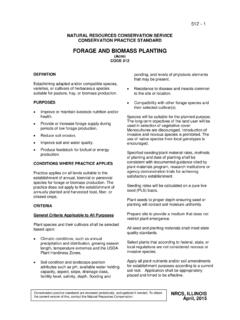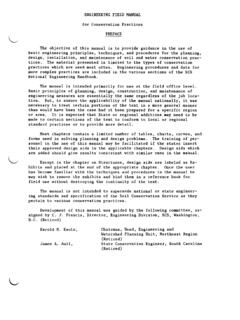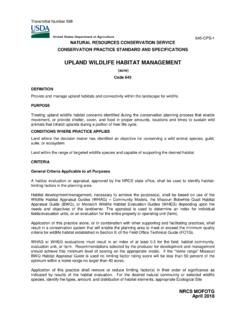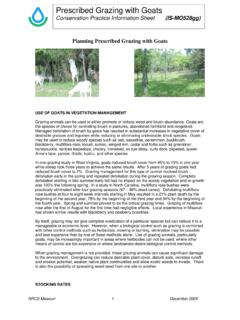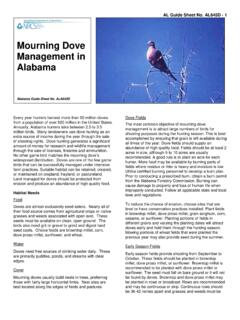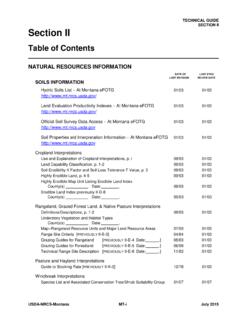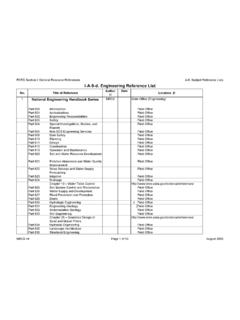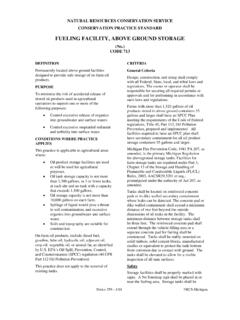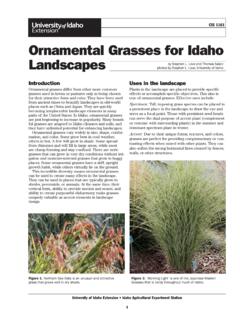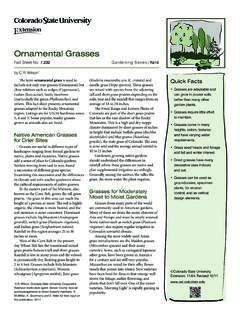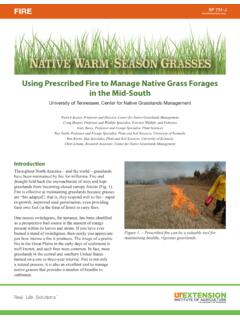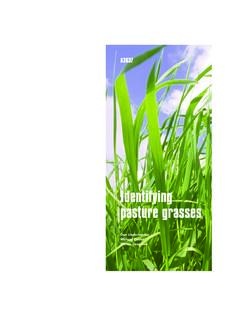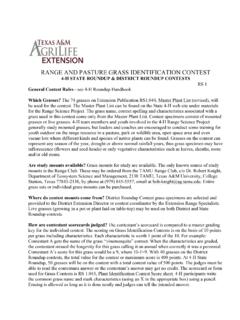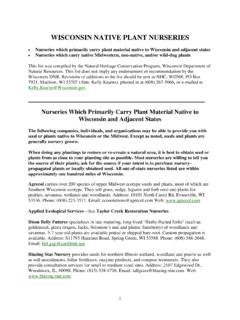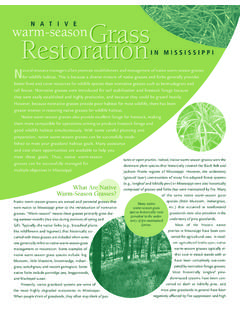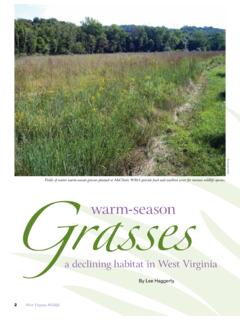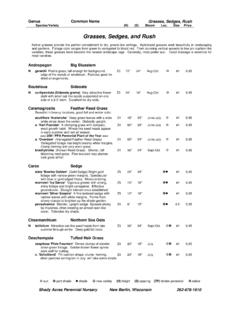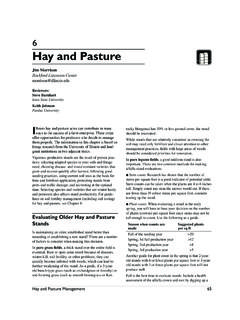Transcription of Native Grasses for Wildlife Habitat - USDA
1 AL Guide Sheet No. AL645C - 1 Wildlife Benefits There are many benefits of establishing a stand of Native warm season Grasses . In addition to being useful as a form of conservation cover or as a forage crop, Native Grasses are beneficial to Wildlife populations. All species of Wildlife have certain basic requirements. These include food, water, cover, space, and arrangement of these items compared to each other. Native Grasses provide both cover and food for many Wildlife species, with warm season grass mixtures providing the most benefits. Properly managed fields provide structure for nesting, protective cover, insect populations for food, and open travel under a tall grass canopy. Native Grasses provide quality Habitat for grassland nesting birds including bobwhite quail, eastern wild turkey, Bachman s sparrow, and many other birds. White-tailed deer utilize Native Grasses for bedding cover.
2 Native Grasses provide both shelter and food for cottontail rabbit and wild turkey. Turkey also use these grasslands for nesting, as well as for brood rearing areas. The poults consume insects such as grasshoppers as a high percentage of their diet for the first several weeks after hatching. Establishment In the past, many have been discouraged from using Native warm season Grasses because they emerge in late spring and grow slowly in the seeding year. A commitment to proper planting and management is necessary in order to assure establishment of a Native grass stand. Seeding rates are provided in this guide sheet for several Native perennial Grasses suitable for Wildlife Habitat in Alabama. Native grass seeding rates are based on pounds of pure live seed (PLS) per acre, not bulk pounds per acre. This is because much of the Native grass seed that is available has a highly variable amount of inert matter such as stems, leaves and awns.
3 Pure live seed is calculated by multiplying seed purity by seed germination. For example, seed with a purity of 65 percent and a germination of 80 percent would yield 52 percent pure live seed per actual pound of seed. In this example, a bag of seed with 40 PLS pounds would actually weigh 77 pounds. The buyer would still only pay for 40 pounds, however. Many Native Grasses use wind to disperse the seed. Therefore, most will have a fluffy awn that aids in dispersal. There are two exceptions. Switchgrass has a small, smooth seed that looks similar to millet. Eastern gamagrass has a cylindrical seed that is about the size of a corn kernel. In addition, those species that normally have a fluffy seed can be treated to make the seed easier to plant. Seed is now available that has had the fluffy awn removed. This debearded seed is much easier to work with than fluffy seed. The recommended spring planting dates* for Alabama are: North Alabama April 1 to July 1 Central Alabama March 15 to July 1 South Alabama March 15 to July 1 Native Grasses for Wildlife Habitat Alabama Guide Sheet No.
4 AL645C AL Guide Sheet No. AL645C - 2 *Planting should not be done during periods of extended drought. Winter planting can also be done in Alabama. Winter planting should only be done after the first heavy frost of the year. Chemical site preparation considerations Pre-planting chemical applications are sometimes necessary to ensure good survival of Native grass plantings. This is particularly true of those areas containing difficult to control Grasses , such as cogongrass, Bermuda grass, tall fescue, johnsongrass, dallisgrass, and bahia grass. Removing many of these plants can be expensive. Imazapyr is one of the best chemicals to use in tank mixes for control of any of the non- Native forage Grasses . Be sure to follow label directions and use highest labeled rates for cogongrass and Bermuda grass. The use of some type of herbicide at planting is strongly recommended, even if a site prep spray was done in late summer of the previous year.
5 This will kill any remaining seed that may have survived the previous spraying. It also provides a window with minimal competition during the early growth period of the planting. A contact herbicide, such as glyphosate, can be used for short term control during the growing season. However, the use of a soil active herbicide will give residual control for an extended period into the growing season. The only soil active herbicide that is currently on the market that will suppress competition without damaging many Native plants is called imazapic. Commercially available as PlateauTM or JourneyTM, these herbicides will not affect many Native forbs, legumes, or Grasses if used per label directions. At the same time, they do a very effective job of controlling johnsongrass, tall fescue, and other hard to control species. Planting Native Grasses can be established by preparing a clean, firm, conventional seedbed or can be established by no-till methods of planting.
6 Native warm season grass drill with fluffy seed box: This type of drill is designed for no-till planting, so seedbed preparation will be minimal. Burning, grazing or close mowing are the most common methods used. These drills have been specifically designed to plant fluffy seed. They have special agitators that move fluffy seed into picker wheels which pull it into the drop tube. Seed should be planted to a depth of 1/8 to inch, with none deeper than inch. Any seed planted deeper than inch will not survive. The one exception to this is eastern gamagrass. It should be planted 1 inch deep, but no deeper than 2 inches. Conventional planting method: When seeding into a conventional seedbed, tillage operations typically used for small seeded forages can be used to prepare a clean seedbed. Plant seeds by drilling or uniformly broadcasting on the freshly prepared seedbed. It is critical that the seedbed be firm (not clodded) or the tiny seed will be covered too deep with loose soil.
7 Loose, uneven, and/or cloddy seedbeds are a major cause of poor stands. Cultipacking prior to planting is a good way to prepare a firm seedbed. When using a grain drill or cyclone style of seeder to plant a conventional seedbed, debearded seed will be the only option. If a grain drill is to be used without a carrier, it will be important to make sure the drill can be adjusted to plant the light rates normally used when planting Native Grasses for Wildlife Habitat . With either type of planting, a carrier of inert material will often be needed to help evenly distribute the small, light seed. If using a cyclone seeder, then crushed peanut hulls, cottonseed hulls or pelletized lime will work well as a carrier. Do not use small grains, such as ryegrass or wheat, as they compete with the Native Grasses . Pelletized lime or fertilizer can work as a carrier with either planting method, but nitrogen must not be used.
8 Nitrogen will cause increased weed competition. Only fertilizers with phosphorus and potassium such as 0-20-20 or 0-46-0 should be used. Seed should be planted to a depth of 1/8 to inch, with none deeper than inch. Any seed planted deeper than inch will not survive. Seed that has been broadcast, should be cultipacked for proper seed to soil contact. No-till planting method: Seedbed preparation will be minimal with this type of planting. Burning, grazing or close mowing are the most common methods used. AL Guide Sheet No. AL645C - 3 When using a standard no-till grain drill to plant, debearded seed will be the only option. It will be important to make sure the drill can be adjusted to plant the light rates normally used when planting Native Grasses without a carrier. A carrier of inert material may be needed to help evenly distribute the small, light seed. Do not use small grains as a carrier, as they compete with the Native Grasses .
9 Fertilizer can work, but nitrogen must not be used. Nitrogen will cause increased weed competition. Only fertilizers with phosphorus and potassium such as 0-20-20 or 0-46-0 should be used. Seed should be planted to a depth of 1/8 to inch, with none deeper than inch. Any seed planted deeper than inch will not survive. Fertilization Soil test the site prior to Native grass establishment. Native Grasses have low fertility requirements and nitrogen application may promote competition from weed growth. Phosphorus and potassium can be applied at planting according to soil test recommendations, but nitrogen should not be applied. If the soil test reports a pH of less than , lime should be used to raise the pH prior to planting. Management During the establishment year. Broadleaf weeds can be controlled by using herbicides labeled for Native Grasses such as Imazapic. Prescribed burning is a beneficial management tool for Native warm season Grasses .
10 Beneficial uses include reducing unwanted vegetation buildup that can reduce Wildlife benefits mentioned above. Most controlled burning should be done in late winter or early spring just before growth of Grasses begins. However, controlled burning should not be done during the nesting season except in certain cases where a burn during the growing season may be needed to control hardwood and shrub competition. Do not burn more than 1/2 of an establishment area in any one-year. Native Perennial Grasses Suitable For Wildlife In Alabama Big bluestem (Andropogon Gerardii) is a Native , warm season perennial bunchgrass that grows well on most soil types. It grows best on moist, well-drained soils, but is more drought tolerant than most warm season Grasses . Big bluestem grows 3 to 6 feet tall and adapted varieties for Alabama are Kaw and Roundtree. The recommended seeding rate for Wildlife Habitat is lbs PLS/acre.

